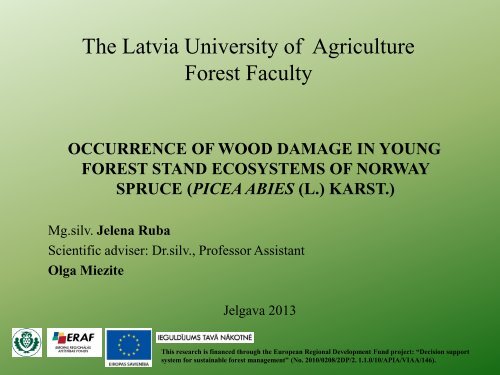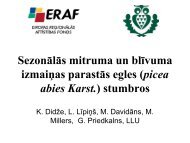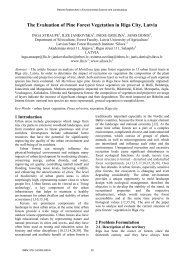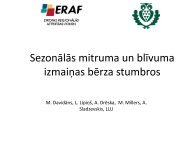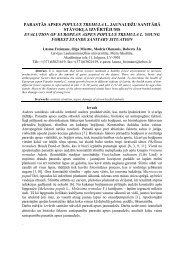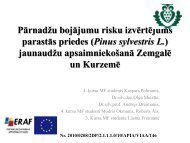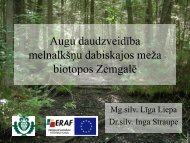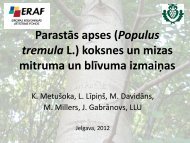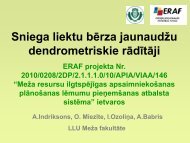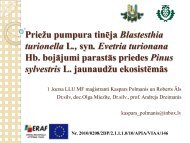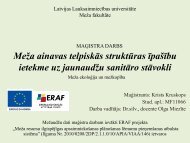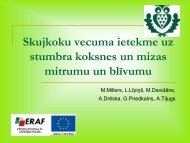The Latvia University of Agriculture Forest Faculty - maplas
The Latvia University of Agriculture Forest Faculty - maplas
The Latvia University of Agriculture Forest Faculty - maplas
Create successful ePaper yourself
Turn your PDF publications into a flip-book with our unique Google optimized e-Paper software.
<strong>The</strong> <strong>Latvia</strong> <strong>University</strong> <strong>of</strong> <strong>Agriculture</strong><br />
<strong>Forest</strong> <strong>Faculty</strong><br />
OCCURRENCE OF WOOD DAMAGE IN YOUNG<br />
FOREST STAND ECOSYSTEMS OF NORWAY<br />
SPRUCE (PICEA ABIES (L.) KARST.)<br />
Mg.silv. Jelena Ruba<br />
Scientific adviser: Dr.silv., Pr<strong>of</strong>essor Assistant<br />
Olga Miezite<br />
Jelgava 2013<br />
This research is financed through the European Regional Development Fund project: “Decision support<br />
system for sustainable forest management” (No. 2010/0208/2DP/2. 1.1.0/10/APIA/VIAA/146).
Research Topicality (1)<br />
Many damages <strong>of</strong> the tree are caused by climate<br />
changes.<br />
Especially roots and crowns <strong>of</strong> the trees are the most<br />
exposed to temperature changes or excessive<br />
humidity when the tree developes.
Research Topicality (2)<br />
Classification <strong>of</strong> tree damages:<br />
- branch and knot damage,<br />
- stem crack,<br />
- wood structure defect,<br />
- fungal and insect damage.
Aim <strong>of</strong> the Research<br />
<strong>The</strong> research was established to determine the wood<br />
damages in 40-year-old Norway spruce (Picea abies<br />
(L.) Karst.) young stands.
Material and Methods<br />
<strong>The</strong> empirical trials were carried out<br />
during the time period from 2011 to<br />
2012 in 34 stands in all <strong>Latvia</strong>n<br />
regions, including 14 single species<br />
stands and 20 mixed ones. Tree<br />
damages were estimated visually in<br />
growing stands and clasiffied.
Results (1)<br />
Percentage distribution <strong>of</strong> Norway spruce<br />
tree damages<br />
1% 1%<br />
1%<br />
97%<br />
Double stem<br />
Crookedness<br />
Spike knots<br />
Healthy trees
%<br />
Results (2)<br />
<strong>The</strong> occurence <strong>of</strong> tree damages in young stands <strong>of</strong> Norway spruce.<br />
4<br />
3<br />
2<br />
4<br />
3<br />
2 2<br />
1<br />
0<br />
0-10 10-20 20-30 30-40<br />
Age groups <strong>of</strong> Norway spruce, years
%<br />
Results (3)<br />
<strong>The</strong> occurence <strong>of</strong> tree damages in young stands <strong>of</strong> Norway<br />
spruce in different regions <strong>of</strong> <strong>Latvia</strong>.<br />
8<br />
7<br />
7<br />
6<br />
5<br />
4<br />
3<br />
2<br />
1<br />
3 3<br />
2<br />
0<br />
Region <strong>of</strong><br />
Zemgale<br />
Region <strong>of</strong><br />
Kurzeme<br />
Region <strong>of</strong><br />
Latgale<br />
Region <strong>of</strong><br />
Vidzeme
Conclusions<br />
1) Spike knots, crookedness and double stems were mostly<br />
found, the occurence <strong>of</strong> each value did not exceed 1%.<br />
2) Occurence <strong>of</strong> wood damage in young forest stands <strong>of</strong><br />
Norway spruce is most founded in age group (0-10) – 4%<br />
but the lowest in (20-30) and (30-40) – 2%.<br />
3) Wood damage occurrence compared by region, was found<br />
that most <strong>of</strong> them were in region <strong>of</strong> Latgale – 7% and<br />
lowest in region <strong>of</strong> Vidzeme - 2%.
Acknowledgments<br />
This research is financed through the European Regional<br />
Development Fund project: “Decision support system for<br />
sustainable forest management” (No. 2010/0208/2DP/2.<br />
1.1.0/10/APIA/VIAA/146).<br />
This research is financed through the European Regional Development Fund project: “Decision support<br />
system for sustainable forest management” (No. 2010/0208/2DP/2. 1.1.0/10/APIA/VIAA/146).
Thank you for attention!


